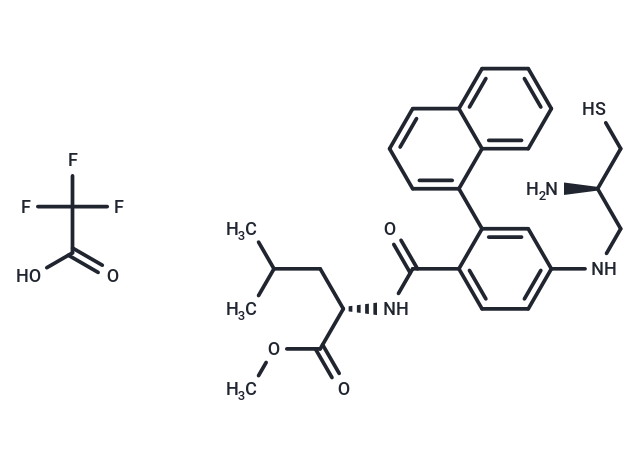Shopping Cart
- Remove All
 Your shopping cart is currently empty
Your shopping cart is currently empty

GGTI298 Trifluoroacetate (GGTI 298 TFA salt) is a geranylgeranyltransferase I inhibitor with ability to arrest human tumor cells in the G1 phase of the cell cycle and induce apoptosis.

| Pack Size | Price | Availability | Quantity |
|---|---|---|---|
| 1 mg | $79 | In Stock | |
| 5 mg | $162 | Backorder | |
| 10 mg | $253 | Backorder | |
| 25 mg | $490 | Backorder | |
| 50 mg | $683 | Backorder | |
| 1 mL x 10 mM (in DMSO) | $213 | Backorder |
| Description | GGTI298 Trifluoroacetate (GGTI 298 TFA salt) is a geranylgeranyltransferase I inhibitor with ability to arrest human tumor cells in the G1 phase of the cell cycle and induce apoptosis. |
| Targets&IC50 | Ha-Ras:>20 μM., Rap1A:3 μM |
| In vitro | The geranylgeranyltransferase I inhibitor GGTI-298 has been shown to arrest human tumor cells in the G1 phase of the cell cycle and induce apoptosis. Treatment of the human lung carcinoma cell line Calu-1 with GGTI-298 results in inhibition of the phosphorylation of retinoblastoma protein, a critical step for G1/S transition. The kinase activities of two G1/S cyclin-dependent kinases, CDK2 and CDK4, are inhibited in Calu-1 cells treated with GGTI-298. GGTI-298 has little effect on the expression levels of CDK2, CDK4, CDK6, cyclins D1 and E, but decreases the levels of cyclin A. GGTI-298 increases the levels of the cyclin-dependent kinase inhibitors p21 and p15 and had little effect on those of p27 and p16. GGTI-298 promotes binding of p21 and p27 to CDK2 while decreasing their binding to CDK6. Its treatment results in an increased binding of p15 to CDK4, which is paralleled with decreased binding to p27. Pretreatment of fibroblasts with GGTI-298, blocks PDGF- and epidermal growth factor-dependent tyrosine phosphorylation of their corresponding tyrosine kinase receptors. GGTI-298 has antiproliferative effects on fibroblasts, epithelial, and smooth muscle cells, and this cell growth inhibition appears to be mediated through a G1 phase arrest[1]. |
| In vivo | GGTI-298 inhibits tumor growth in nude mice[1]. |
| Cell Research | Cells were treated with GGTI-298 (15 μM) for 48 h, harvested, and lysed in HEPES lysis buffer. Proteins were then resolved by 12.5% or 7% SDS-PAGE gel and immunoblotted with antibodies. The ECL blotting system was used for detection of positive antibody reactions.(Only for Reference) |
| Alias | GGTI 298 TFA salt |
| Molecular Weight | 593.66 |
| Formula | C27H33N3O3S·C2HF3O2 |
| Cas No. | 1217457-86-7 |
| Smiles | OC(=O)C(F)(F)F.COC(=O)[C@H](CC(C)C)NC(=O)c1ccc(NC[C@@H](N)CS)cc1-c1cccc2ccccc12 |
| Relative Density. | no data available |
| Storage | store at low temperature,keep away from moisture | Powder: -20°C for 3 years | In solvent: -80°C for 1 year | Shipping with blue ice. | |||||||||||||||||||||||||
| Solubility Information | DMSO: 14.8 mg/mL (24.93 mM), Sonication is recommended. | |||||||||||||||||||||||||
Solution Preparation Table | ||||||||||||||||||||||||||
DMSO
| ||||||||||||||||||||||||||

Copyright © 2015-2025 TargetMol Chemicals Inc. All Rights Reserved.